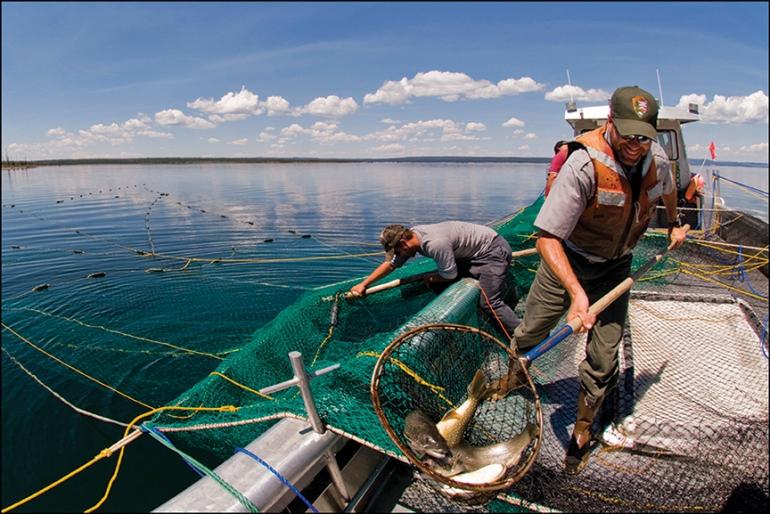A Trout Is a Trout
As Captain Phil maneuvered the gillnetting boat out from the docks and into the deep 66-degree frigid waters of Yellowstone Lake, Pat Bigelow, fisheries biologist for the park, explained our duties on board. One person would guide in the nets while the rest of us stationed ourselves on either side of a large metal table that took up most of the space in the Freedom, a boat custom-made for this task.
Bogged down by heavy fishing gear and oversized gloves to protect us from the oncoming slime fest, the near-dead, stinky-dead, and wished-they-were-already-dead-because-you-had-to-whack-them-on-the-head-dead lake trout were soon coming our way. It took five of us about an hour to pull up a consecutive run of six nets, each net close to 100 meters long and two meters tall. Pat gave us a wry smile as she told us these nets had been in a little longer than normal. Some of the lake trout we pulled—and I say pulled to spare you from the agonizing detail of squeezing a four- or five-inch-diameter object through a 1”-1 ½” hole—were a little more ripe than others. This was our first day with the Yellowstone Institute’s Native Trout Conservation course, our baptism into the somewhat controversial world of saving the largest population of genetically pure inland cutthroat trout in North America.
We netted a little over 30 lake trout, contributing just slightly to the 12,000 caught by June of 2006 and the 139,000 netted and eradicated from 1994 to 2005. To date, Yellowstone is in its seventh year of the largest suppression program for the removal of non-native fish in the U.S. This national treasure, often thought of as "trout Shangri-la" with its mythic reputation as a world-class fishery, blue-ribbon waters, and epic aquatic hatches, is in danger of losing this keystone species, which has declined 11% annually since 1994.
Along with my 11 classmates, most of them avid fishermen, some hands-on conservationists, teachers, biologists, and a few of us mere interested parties, I was fortunate to experience these conservation efforts firsthand through this in-depth course at the Lamar Buffalo Ranch this past summer. After a few hours of classroom activities, Bob Gresswell, Ph.D. and research biologist with the USGS Northern Rocky Mountain Science, and Mike Rule, the technical lead for fish restoration in the Park, led us in our restoration activities. After the Yellowstone Lake gillnetting experience, we took our waders, nets, and enthusiasm to Rose Creek for an afternoon of completing a "stream inventory" (a.k.a., electro-shocking, measuring, weighing, fin-clipping, and categorizing cutthroat and non-native rainbows and hybrids). We attempted a spawning stream survey but seemed to be missing the key participants (apparently we were a week or two off the season this year). Before, during, and I must admit even after the Institute’s course, for me the question was this: What is the importance of saving the genetic purity of a fish?
The key to answering this question is first to understand Yellowstone’s conservation and preservation program. There are two facets to this effort. The first is ridding Yellowstone Lake of the carnivorous non-native lake trout that are decimating the native cutthroat trout population. This part of the program makes 100% sense to me. Unlike the native cutthroat trout, lake trout live in the deep waters of Yellowstone Lake, inaccessible to the more than 42 Yellowstone National Park species that rely on the cutthroat for its high protein content and digestibility. So goes the lake’s cutthroat trout, so goes the osprey, the grizzly, the otter, and the mink along with many other animals in the park.
The second part of this effort is restoring genetically pure native Yellowstone cutthroat, westslope cutthroat, and arctic grayling populations to their original Yellowstone Park stream and river habitats. In the Park’s earlier years, over 310 million non-native and native fish were indiscriminately stocked in Yellowstone’s waters, mostly to compensate for extreme overfishing and to ensure fishing opportunities for many generations to come. (This doesn’t count the number brought in by bucket biologists—which is illegal in the park at this time.) Unfortunately, the non-native populations, which include rainbows, brook, and lake trout, have not only adapted but are wiping out a unique genetic resource.
Yellowstone is not alone in tackling this issue. Flathead Lake, Paradise Valley, and many other states including Idaho, Colorado, Utah, and others are working on saving the genetic purity of their natives. (Interestingly enough, some of our natives are the aggressors in their waters. Sometimes it hard to keep track of who’s on first base.)
There are important reasons to maintain diversity and native wildlife in the park—and fish are a part of that wildlife. Our class appeared to be in cohesion regarding the importance of the Yellowstone Lake project. However, perhaps not quite as clear-cut was the issue of genetic purity in regard to Yellowstone’s hybrid populations in the Park's rivers and streams. Is it that important to maintain a specific genetic species of fish in the waters that it got stuck in during the ice age?
I walked away from this course with almost as many questions as answers. I also walked away with a course catalog for the Yellowstone Institute and the desire to sign up for as many classes as possible. Their instructors are extremely knowledgeable, Lamar Buffalo Ranch is a wondrous place to drop your bedroll, and the chance to get your hands dirty and really get involved in Yellowstone is an experience that should definitely be on your top-ten list of things to do. I guess on second thought, considering that the objective of the Park is to preserve the natural and cultural ecosystems for the educational, scientific, and cultural benefit of U.S. citizens, it may be indeed that not all trout are created equal, and some need a helping hand in to survive and flourish for future generations.
A Fork in the River: The Gallatin's big bet on the Westslope cutthroat reintroduction
You’ll have a tougher time finding cutthroat in the Gallatin River drainage outside of Yellowstone Park. “There was a time when every stream [in the drainage] accessible to fish had Westslope cutthroat,” says Lee Nelson, Fisheries Biologist for Region 3 of Montana Fish, Wildlife & Parks. A number of factors have reduced cutthroat populations to just two streams in the Gallatin River drainage, or 0.5% of their estimated historic range.
But hope for a Westslope cutthroat rebound lays in one of those streams—the West Fork of Wilson Creek near Gallatin Gateway. Nelson is leading an effort to introduce genetically pure Westslope cutthroat into a four-mile-long fishless stretch of Elkhorn Creek, which flows into the Gallatin above Big Sky. The West Fork of Wilson Creek would serve as the donor stream. “We want to keep the fish as local as possible,” said Nelson. The fish raised in Elkhorn Creek would have a greater chance of survival if they perpetuate the genetic characteristics of the West Fork of Wilson population.
The introduction stalled this past spring because of high water in mid-June during the spawn. If all goes well, the fish will be introduced early next summer, and the four-mile stretch of Elkhorn Creek could be home to 2,000 Westslope cutthroats within three to five years.
-Dave Barker
Famous Casts: The Headwaters Fly Fishing Club Hall of Fame makes first inductions
Among local anglers, the mere mention of the names Darwin Atkin, Bud Lilly, and Tom Morgan produces a feeling of awe akin to fighting a trophy brown trout on a 4-weight rod. On October 27, the three fly fishing icons will be honored at the Best Western Grantree Inn where they’ll be the first inductees into the Headwaters Fly Fishing Club’s “Legends of the Headwaters” Fly Fishing Hall of Fame.
“They have a fly fishing hall of fame in San Francisco… and the fly fishing hall of fame on the east coast… but there was nothing in the Rocky Mountain area that recognized the people who made it the mecca that it is,” says event organizer and Headwaters Fly Fishing Club (HWFF) board member Dick Monroe. “They deserve to be applauded by their peers and the rest of the community.”
The HWFF board chose the three based on their significant impact on the sport of fly fishing. Atkin was the Federation of Fly Fishers (FFF) Man of the Year in 1996 and has raised tens of thousands of dollars for the FFF, which is based in Livingston. Lily grew up in nearby Manhattan and was one of the first advocates of catch-and-release fishing after observing the effects of overfishing in Yellowstone National Park. Morgan is a world-famous rod builder who owned Winston Rod Company for close to 20 years before starting Tom Morgan Rodsmiths in Manhattan. “The attitude that Tom Morgan has and his desire for perfection in everything he produces is so strong that it emanates,” says Monroe.
The induction ceremony is part of the day-long fly fishing festival which is free to the public and complete with fly-tying demonstrations, fly-shop symposiums, casting instruction, and a screening of the movie Three Men, Three Rivers. Tickets to the banquet and induction ceremony are $45. For more information on Legends of the Headwaters or HWFF, which holds monthly meetings from September through June, call 388-9510 or visit hwff.org.
-Dave Barker











